For people that speak Portuguese, I believe my own book is the best resource to help you eliminate your errors, you can read a sample here, however, it’s not possible to cover all English grammar, I only cover the points that cause problems. In order to cover all grammar points a specialist grammar book is needed.
Let’s take a look at two of the best English grammar books for students that I have used. They are Practical Grammar Level 3 by John Hughes and Ceri Jones and the popular English Grammar in Use by Raymond Murphy, which is the world’s best-selling grammar book according to its front cover.
Practical Grammar Level 3 by John Hughes and Ceri Jones
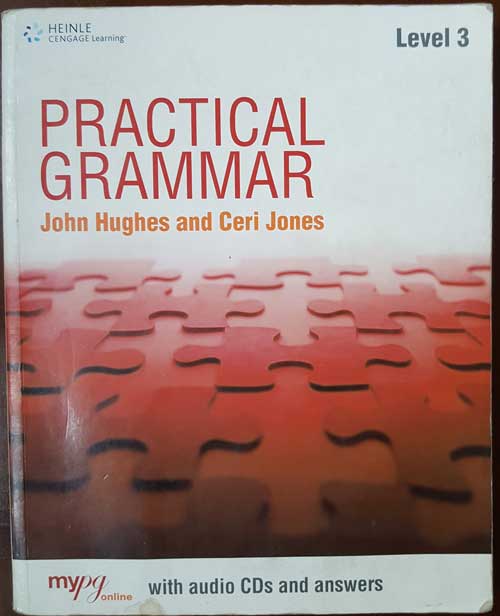
This book was recommended to me by International House Dublin where I did the CELTA teacher training course to become a certified Teacher of English as a Foreign Language back in 2013. International House Dublin have taught the CELTA course to native English speakers in Dublin for many years, so I figured that if they are recommending it then it must be good.
It has a similar layout to English Grammar in Use by Raymond Murphy in that each of the 100 units including revision units is on two pages with theory on the left-hand page and exercises on the right, as below.
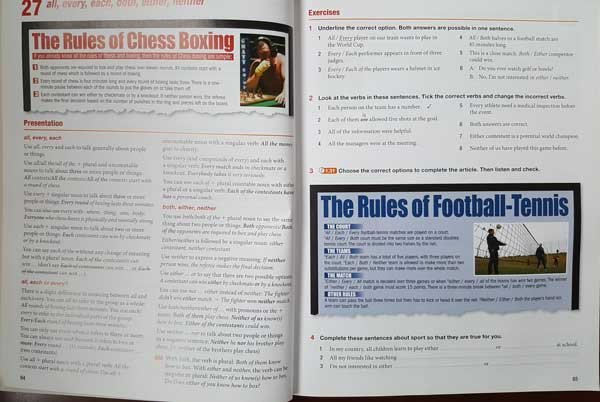
Also, like the Murphy book, it is not designed as a book that you work through in sequence, for example starting on unit 1 and completing all units to 100. It is used as a reference guide so that when you have a question or don’t understand a particular grammar point you read the relevant unit for an explanation and practice the exercises.
The book is structured with basic verb tenses such as present simple and present continuous at the beginning, working towards more complicated verb tenses such as past perfect, before moving on to topics such as questions, adjectives, comparatives, prepositions, phrasal verbs, modal verbs, reported speech, the passive, relative clauses and more.
As a teacher, I find that having a grammar book that presents topics clearly and with good examples is essential, especially if you do not have internet access during class. Some grammar points are very subtle and require a precise definition rather than explaining them spontaneously or “off the top of your head”, as we native speakers say. If a student asks you a question the answer will probably be in the book and you can work through one topic per class and do the exercises.
There are good, simple, clear timelines which are a key element to explain and to help students visualise how verb tenses work.
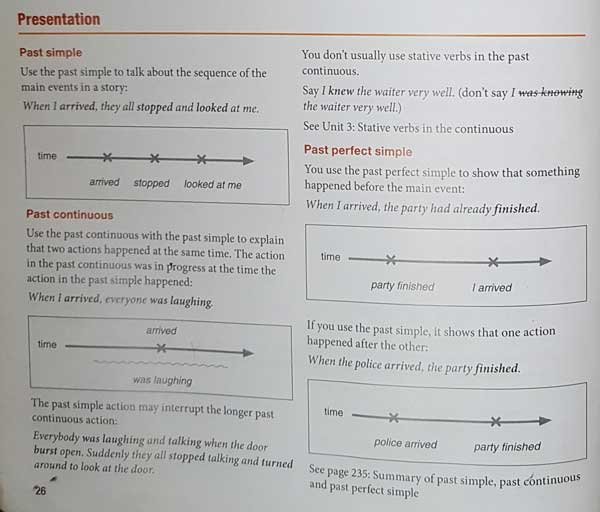
However, sometimes the layout of each page contains a lot of text and is not broken down into sections like in English Grammar in Use. This can make it unappealing to study.

All exercises have answers at the back of the book along with tapescripts for the audio exercises that come on a CD with the book.
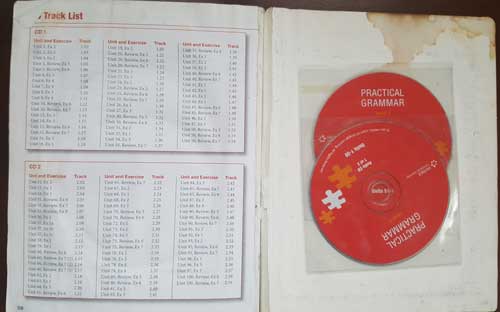
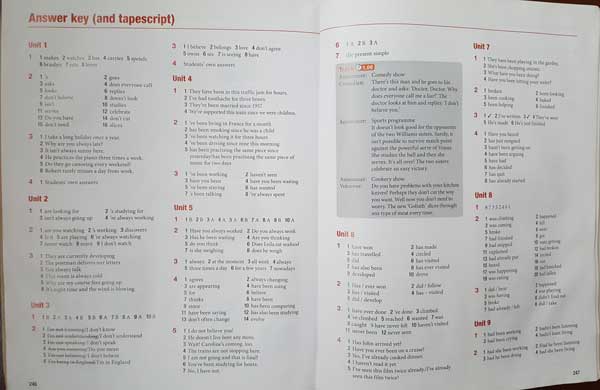
However this book does seem more difficult to find, I bought it from Amazon. I haven’t seen any student with this book yet but I frequently see English Grammar in Use by Murphy in bookshops and schools and many students are familiar with it.
Another feature I like are the appendices at the end of the book. They are visual, using good examples of images and also have timelines.
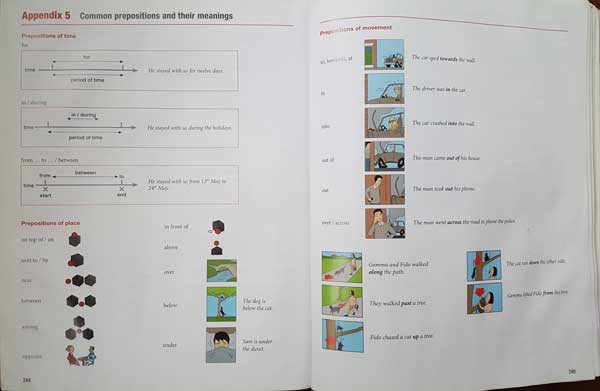
Every student needs a grammar book, so if you don’t have a grammar book yet then this one is certainly a good choice.
English Grammar in Use by Raymond Murphy
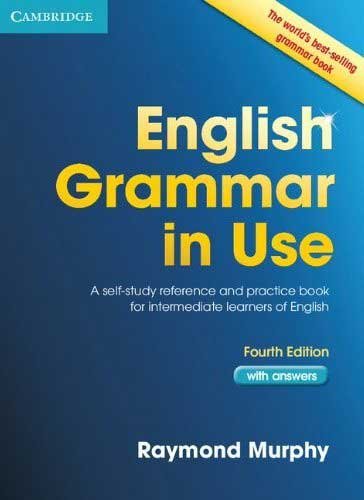
I have used this grammar book for many years in class, but that doesn’t mean that it is perfect. I know its good points and faults and it does seem to be the most popular one among students and the one that they are most familiar with. It is also easier to find in bookshops around the world, certainly relatively easy to find in Brazil. However, if you can’t find it in your local bookshop then you can buy it online on Amazon or from other online retailers.
Like Practical Grammar by Hughes and Jones, each unit also contains two pages. The left page is theory, helpfully broken down into sections, from A right through B, C, D, E and up to F, and the right-hand page has exercises for you to practice with answers in the back.
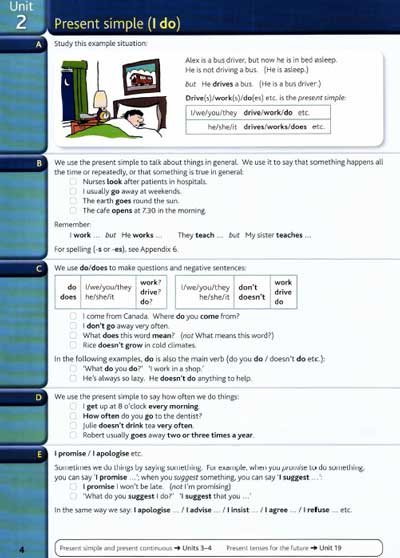
This A,B,C,D,E, F breakdown is useful and is an advantage over Practical Grammar. The important theory is in section A at the top and will usually have good images to illustrate the grammar point. Then the book expands on this in section B with more examples. Some units might have sections C,D,E, F, others do not, these sections show you more examples and uses, and they may also introduce exceptions to the rule and unusual cases.
One of the problems with the book is that sometimes these sections, especially sections D, E and F, are not very clear and can be confusing to me as a teacher so they can very confusing to students. In the image above, section E is a minor grammar point and is not very clear, if you don’t understand it then don’t worry about it. If you don’t understand sections A and B then it is time to worry!
This is not the case in every unit, just some units, so I always advise my students that if they are studying at home to not worry if they don’t understand sections D, E or F. It’s not their fault, it is the author’s fault for not explaining it well and usually you are dealing with rare exceptions so they are not terribly important.
However other parts of the book are very well designed, take a look at this example:
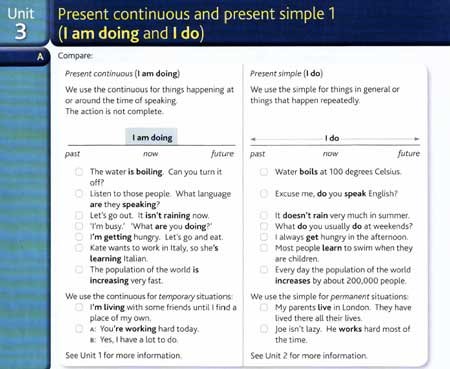
I like that they put two contrasting grammar ideas side by side, they then use the same base sentence in the examples but just change the verb. This changes the whole meaning of the sentence but brilliantly shows how the verb tenses are used in everyday speaking.
In this example, The water is boiling and Water boils.
My other gripe [‘gripe’ is an informal word for a complaint] is that sometimes the sentences used in the examples contain expressions and phrasal verbs. Look at unit 2 again:
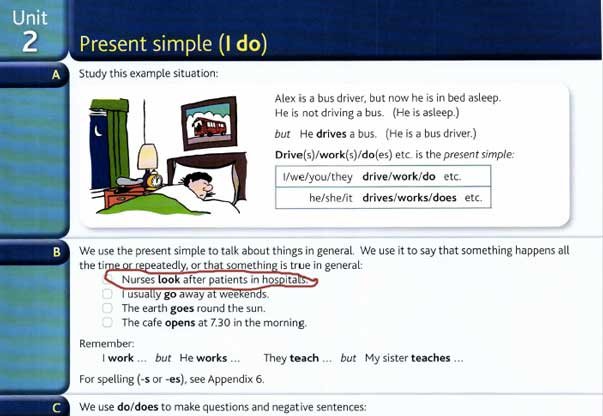
The book is explaining the present simple which is a basic grammar point that beginners learn, but then they use an example sentence with a phrasal verb, to look after, that beginners and even advanced students might have a problem with.
to look after means to care, cuidar to Portuguese speakers. Phrasal verbs are important for more advanced students but I think it is a bad idea to use them in this case, they should use to care or use a completely different example.
However, I do understand that beginners will probably use a grammar book in their native language rather than a grammar book in English.
The problem above is that native speakers use phrasal verbs so often that we don’t realise we are using them. We forget that it is difficult for non-native speakers to understand them, I’m sure this is what happened here. It was an oversight, a mistake that they didn’t realise they were making. The author didn’t think of using a more straightforward sample sentence as we use phrasal verbs naturally.
The book is sensibly laid out having phrasal verbs at the end. This phrasal verb section is the closest I have seen to a strategy for phrasal verbs, but unfortunately, probably the best way to learn them is to learn the ones that are used in everyday speaking or in Business English. There are thousands of them and most you don’t need to know but others are very important.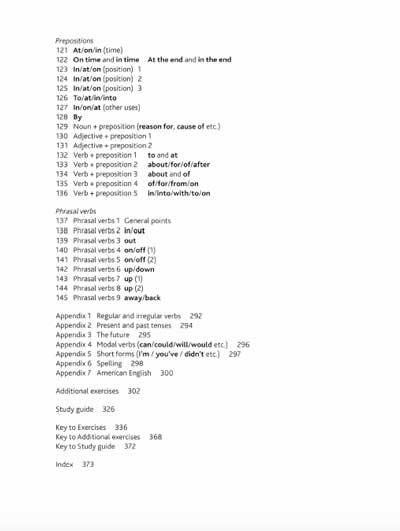 Also, notice that there are 17 units on prepositions. Reading lists of rules and studying all these units is a terrible way to learn prepositions. That’s why sitting down and studying the book can be a bad idea. What you need to do is simply to learn a couple of key strategies so you can think through the problem of which preposition to use, these strategies are also in my books. Prepositions are difficult for all students of English but are especially difficult for Portuguese speakers as there are many more prepositions in English than Portuguese.
Also, notice that there are 17 units on prepositions. Reading lists of rules and studying all these units is a terrible way to learn prepositions. That’s why sitting down and studying the book can be a bad idea. What you need to do is simply to learn a couple of key strategies so you can think through the problem of which preposition to use, these strategies are also in my books. Prepositions are difficult for all students of English but are especially difficult for Portuguese speakers as there are many more prepositions in English than Portuguese.
However, it is good to have all these 17 units as a reference. For me, as a teacher, I might get asked a question on a specific use of a preposition and the answer, examples and explanation will be in the book.
The appendix at the end of the book on the difference between British and American Engish is useful and there is also a study guide quiz to test your knowledge, if you don’t know the answer then it tells you which units to study.
To Summarise
English Grammar in Use by Raymond Murphy is the book I use in class and is easier to find in your local bookshop, the disadvantages I have found with it come from the fact that I have used it for many years in my classes. Those disadvantages are that sometimes very minor grammar points can be confusing and there are some bad sample sentences used.
Either book is fine for students, if you find one is significantly cheaper than the other then certainly go for that one, you won’t regret it.
As Murphy is the world’s best-selling grammar book it might be easier to find that one or you can buy the books online on Amazon.
However, for Portuguese speakers, the biggest problem is that grammar points that are uncomplicated for Portuguese speakers have the same number of pages in the book as grammar points that are very difficult for Portuguese speakers.
For example, the present perfect is listed as rules to follow over the course of a couple of units but you do not understand WHY or WHEN to use it. After teaching the present perfect to dozens of students over the years I have developed my own 60-minute class for pre-intermediate students. I have constructed this 60-minute class in my book along with exercises to help you. The present perfect is a whole different way of thinking for Portuguese students, it is not used in Portuguese so translating directly will not work, you need to understand the WHY first, then you can remember the rules. I promise that if you read over the 60-minute present perfect unit in my book you will have a far better understanding of this critical tense.
You can also read here about 10 songs with past continuous in English. Or discover about the origin of the English language in here.
In here, you can learn how to create a study routine to learn English.
Or click here to learn about 7 songs with modal verbs.
What are your thoughts? Leave a comment below and please share with your friends.
